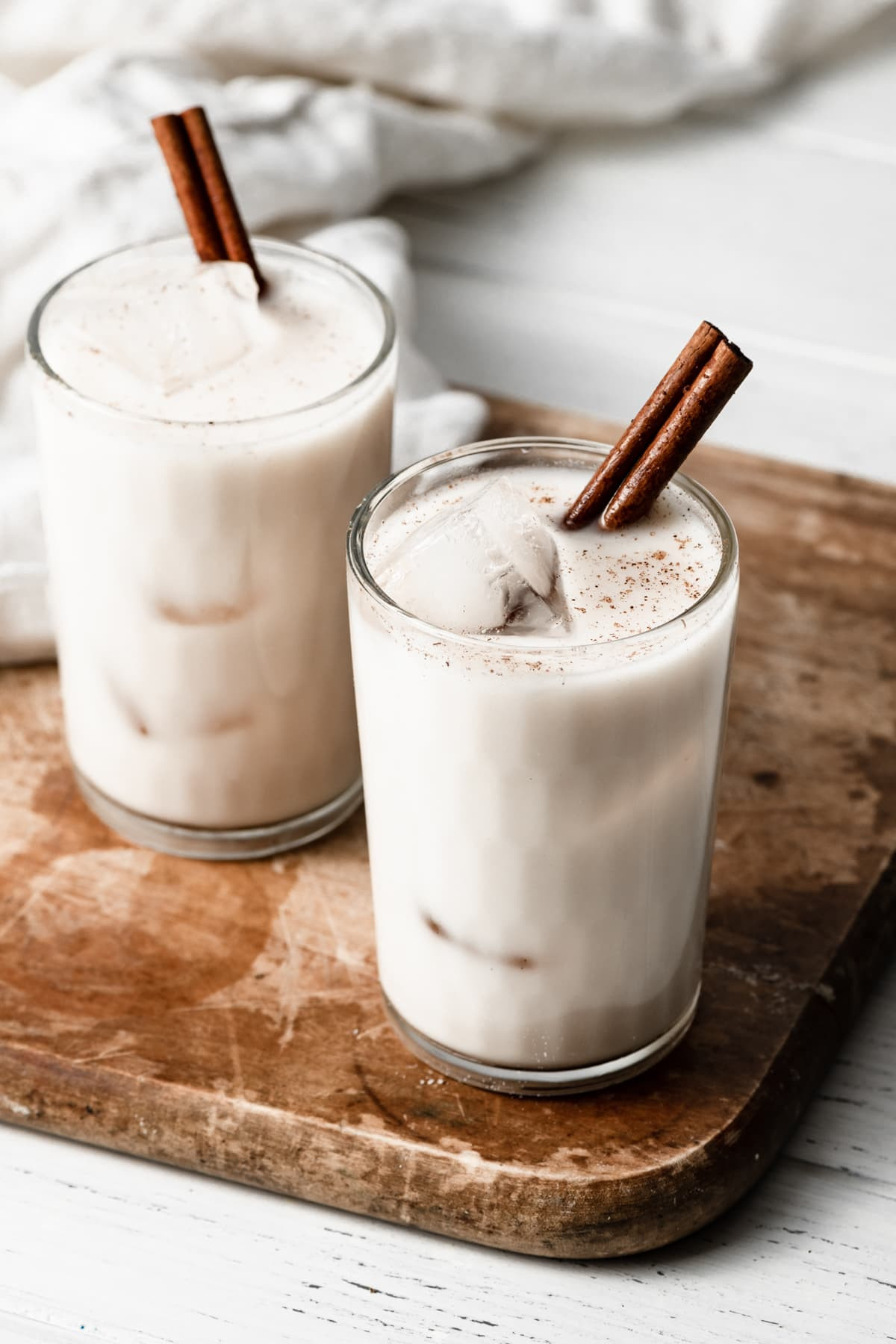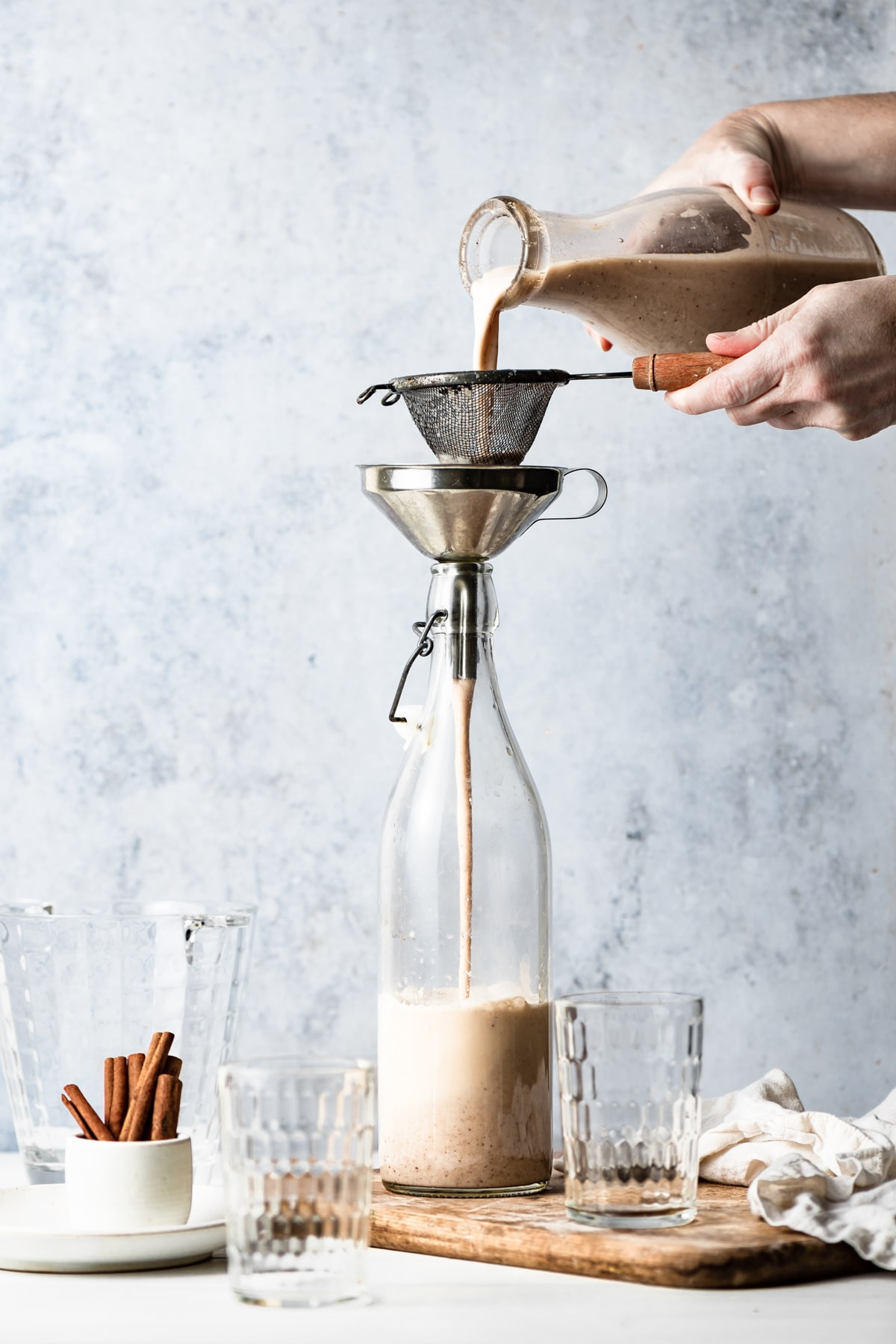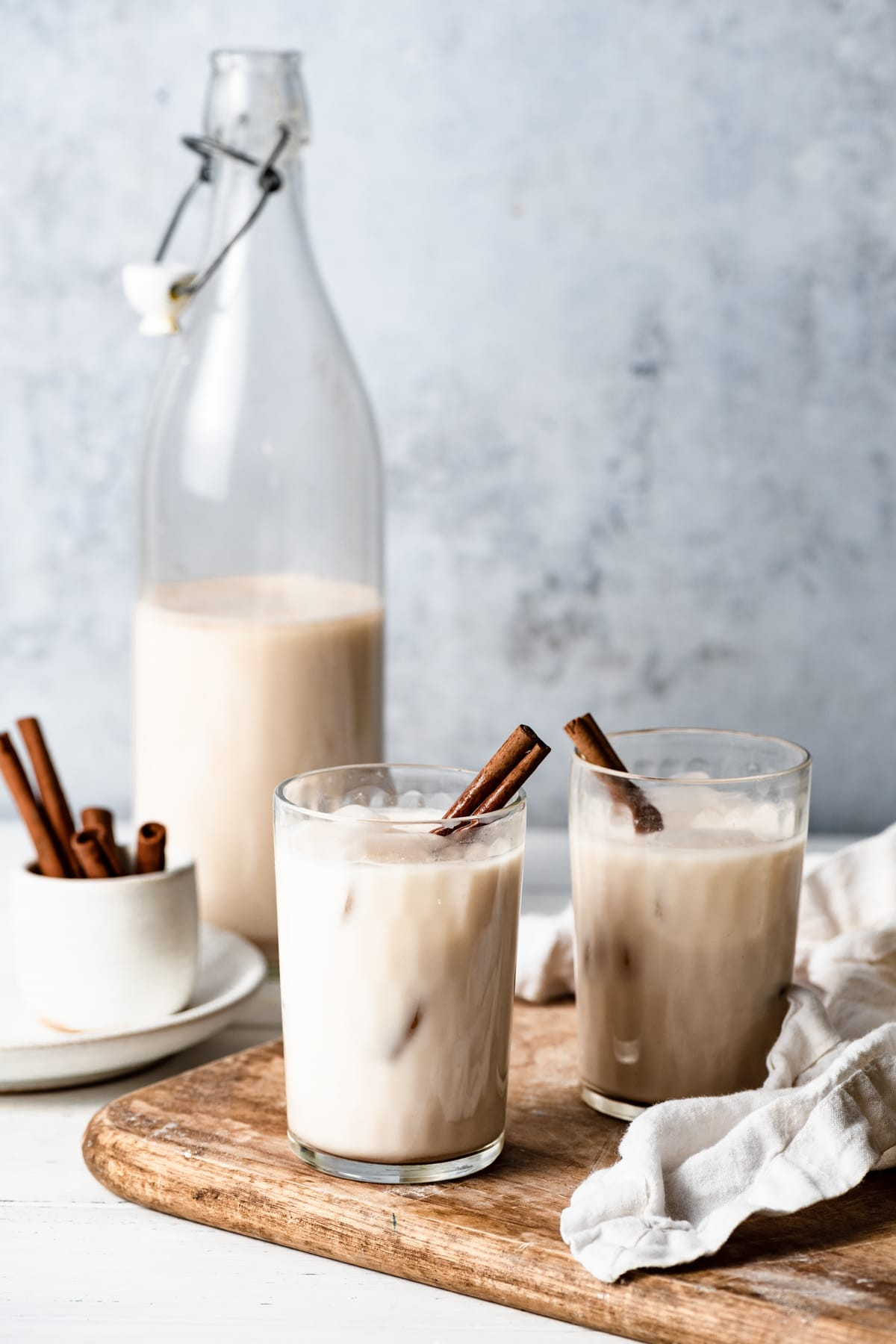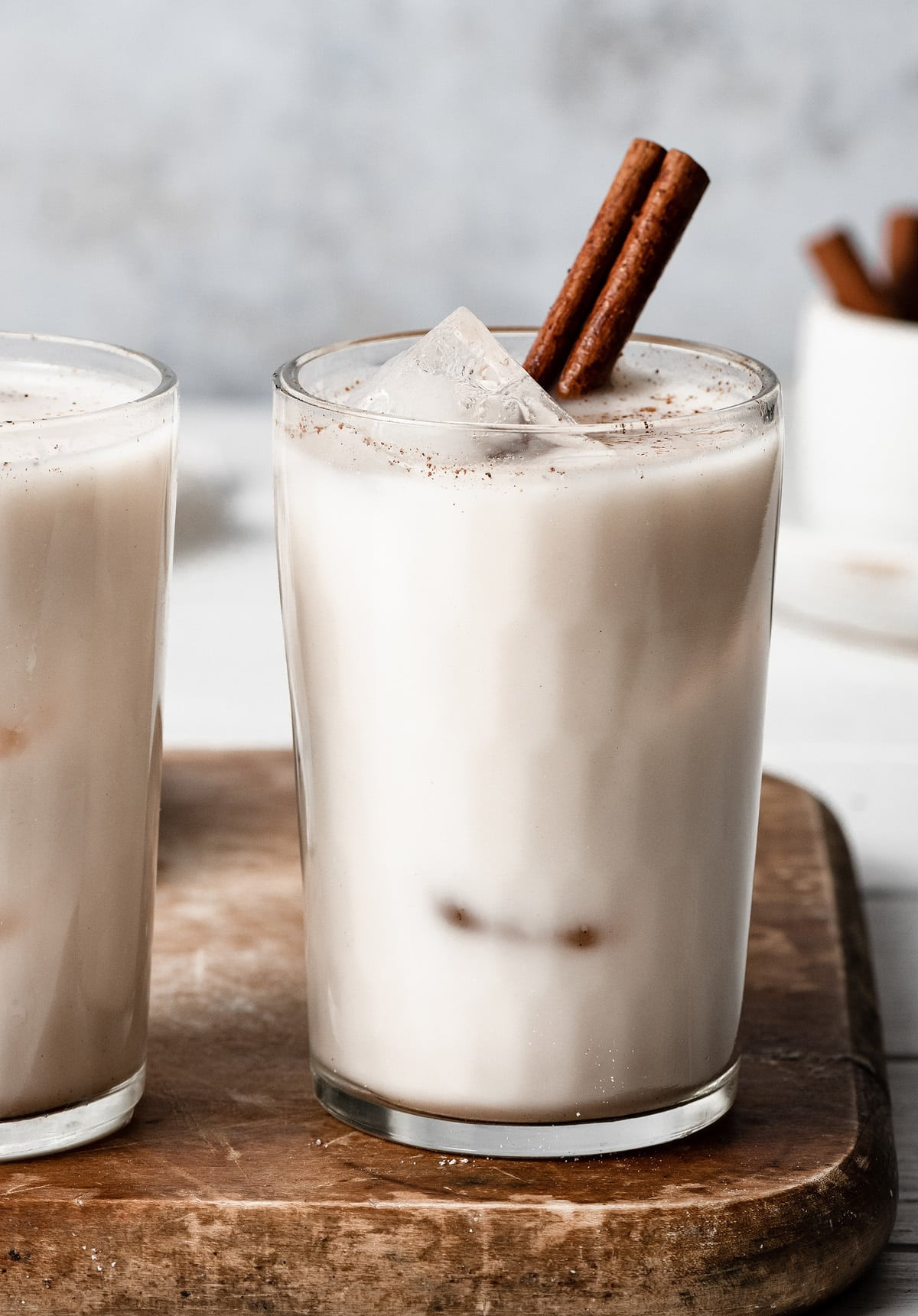Looking to explore the vibrant culinary landscape of Mexico and its LGBTQ+-friendly destinations? At gaymexico.net, we’re passionate about connecting you with authentic cultural experiences, including the delicious and refreshing world of Mexican beverages. This guide will delve into the beloved Mexican rice drink, Horchata, offering you insights into its preparation, variations, and cultural significance. Discover the perfect sip to complement your Mexican adventure and remember to visit gaymexico.net for more on LGBTQ+ travel in Mexico.
1. What Exactly Is Horchata?
Horchata is a traditional and refreshing Mexican beverage primarily made from white rice soaked in water. This milky drink is typically flavored with cinnamon and sweetened with sugar. The rice, cinnamon, and sweetener are blended, and then the mixture is strained to remove solids, resulting in a smooth, creamy texture. Horchata is a beloved drink across Mexico, often enjoyed as a cool respite from the heat, especially during the warmer months.
 Horchata in two glass cups with ice cubes and a cinnamon stick. Cups are set over a wooden cutting board.
Horchata in two glass cups with ice cubes and a cinnamon stick. Cups are set over a wooden cutting board.
1.1 What Are the Different Variations of Horchata?
Horchata recipes can vary significantly across different regions and even individual households. Some common variations include:
- Dairy vs. Dairy-Free: While some recipes incorporate milk (such as whole milk or evaporated milk) for added creaminess, others remain entirely dairy-free, using water as the sole liquid base. For a dairy-free version, consider using coconut milk or almond milk.
- Nut Additions: Some horchata recipes include nuts, such as almonds or peanuts, to enhance the flavor and texture.
- Flavor Enhancements: Additional flavors like vanilla extract, coconut, or citrus zest can be added to customize the taste.
- Regional Differences: Different regions in Mexico have their own unique twists on horchata. For example, in some areas, it might be thicker or sweeter, while in others, it might be lighter and more subtly flavored.
1.2 What Makes Horchata a Popular Drink in Mexico?
Horchata’s popularity in Mexico stems from several factors:
- Refreshing Quality: Its cool and refreshing nature makes it an ideal beverage for combating the Mexican heat.
- Cultural Significance: Horchata is deeply rooted in Mexican culinary traditions, often enjoyed during family meals, celebrations, and everyday occasions.
- Versatility: It pairs well with a wide range of Mexican dishes, from spicy tacos to sweet desserts.
- Accessibility: The basic ingredients are readily available and relatively inexpensive, making it an accessible beverage for many.
- Nostalgia: Many Mexicans associate horchata with childhood memories and the comforting flavors of home.
1.3 Are There Any Health Benefits of Drinking Horchata?
While horchata is primarily enjoyed for its flavor and refreshing qualities, it can also offer some nutritional benefits:
- Hydration: As a water-based beverage, horchata helps keep you hydrated, especially important in warm climates.
- Energy Source: The rice and sugar provide carbohydrates, which can offer a quick source of energy.
- Vitamins and Minerals: Depending on the ingredients used, horchata may contain small amounts of vitamins and minerals, such as calcium (if milk is added) or vitamin E (from almonds).
- Digestive Health: Rice water, a key component of horchata, has been traditionally used to soothe digestive issues.
- Dairy-Free Option: Dairy-free versions of horchata are a good option for those with lactose intolerance or dairy allergies.
2. How Is Authentic Mexican Horchata Typically Made?
The traditional method of making horchata involves several key steps, each contributing to the drink’s unique flavor and texture. While specific recipes vary, the general process remains consistent.
2.1 What Are the Core Ingredients for Traditional Horchata?
The essential ingredients for making authentic Mexican horchata include:
- White Rice: Long-grain white rice is most commonly used, providing the drink’s characteristic milky flavor and texture.
- Water: Used for soaking the rice and creating the liquid base of the drink.
- Cinnamon: Cinnamon sticks add a warm, aromatic spice that is essential to horchata’s flavor profile.
- Sugar: Granulated sugar is the typical sweetener, but other options like maple syrup or honey can be used.
- Vanilla Extract (Optional): Adds a hint of vanilla flavor, enhancing the overall sweetness and aroma.
2.2 What Is the Traditional Preparation Process?
- Soaking the Rice: The rice is soaked in water for several hours, or even overnight, to soften it and allow its flavors to infuse into the water.
- Blending: The soaked rice, along with cinnamon sticks and additional water, is blended until the rice is finely ground.
- Sweetening and Flavoring: Sugar and vanilla extract (if using) are added to the blended mixture and blended again to dissolve the sugar.
- Straining: The mixture is strained through a fine-mesh sieve or cheesecloth to remove the solids, resulting in a smooth, creamy liquid.
- Chilling: The strained horchata is chilled in the refrigerator before serving.
2.3 What Equipment Do You Need to Make Horchata?
To make horchata at home, you’ll need the following equipment:
- Blender: A high-speed blender is ideal for grinding the rice into a fine consistency.
- Large Bowl or Container: For soaking the rice.
- Fine-Mesh Sieve or Cheesecloth: For straining the mixture and removing solids.
- Pitcher: For storing and serving the horchata.
- Measuring Cups and Spoons: For accurate ingredient measurements.
 Showing how to make horchata, pouring blended mixture through a fine mesh sieve into a pitcher.
Showing how to make horchata, pouring blended mixture through a fine mesh sieve into a pitcher.
3. How Can You Customize Your Horchata Recipe?
One of the great things about horchata is its versatility. You can easily customize the recipe to suit your taste preferences and dietary needs. Here are some ideas:
3.1 Can You Make Dairy-Free Horchata?
Yes, it’s easy to make dairy-free horchata. Simply omit the milk (if the recipe calls for it) and use water or a plant-based milk alternative instead. Good options include:
- Almond Milk: Adds a subtle nutty flavor.
- Coconut Milk: Provides a creamy texture and a hint of coconut flavor.
- Soy Milk: A neutral-tasting option that works well as a base.
- Rice Milk: Enhances the rice flavor of the horchata.
3.2 What Are Some Alternative Sweeteners for Horchata?
If you’re looking to reduce your sugar intake or prefer a different sweetener, you can substitute the granulated sugar with:
- Maple Syrup: Adds a rich, caramel-like flavor.
- Honey: Provides a floral sweetness.
- Agave Nectar: A neutral-tasting liquid sweetener.
- Stevia: A sugar-free option for those watching their blood sugar levels.
- Monk Fruit Sweetener: Another sugar-free alternative with a clean taste.
3.3 Can You Add Different Flavors to Horchata?
Absolutely! Experimenting with different flavors can create exciting variations of horchata. Some popular additions include:
- Cinnamon: Enhance the cinnamon flavor by adding ground cinnamon to the mixture.
- Vanilla: A splash of vanilla extract enhances the sweetness and aroma.
- Citrus Zest: Add lime, lemon, or orange zest for a refreshing twist.
- Coconut: Add coconut flakes or coconut extract for a tropical flavor.
- Chocolate: Mix in cocoa powder for a chocolatey horchata.
- Coffee: Add brewed coffee for a caffeinated kick.
4. How Does Horchata Fit into Mexican Culture?
Horchata is more than just a refreshing drink; it’s an integral part of Mexican culture and traditions. It is often served at family gatherings, celebrations, and festive events.
4.1 What Is the History of Horchata in Mexico?
Horchata’s origins can be traced back to ancient Egypt, where a similar drink was made from tiger nuts. The Moors brought the drink to Spain, where it became popular in the Valencia region. From Spain, horchata made its way to Mexico during the colonial era.
4.2 When Is Horchata Typically Served in Mexico?
In Mexico, horchata is enjoyed year-round, but it’s especially popular during the hot summer months. You’ll find it served:
- At restaurants and cafes: As a refreshing accompaniment to meals.
- At family gatherings: During celebrations and casual get-togethers.
- At street food stalls: As a thirst-quenching option for passersby.
- During festivals and holidays: As part of the festive atmosphere.
4.3 How Does Horchata Reflect Mexican Culinary Traditions?
Horchata reflects several key aspects of Mexican culinary traditions:
- Use of Local Ingredients: The drink is made with readily available ingredients like rice, cinnamon, and sugar.
- Emphasis on Freshness: Horchata is best when made fresh, highlighting the importance of using high-quality ingredients.
- Balance of Flavors: The combination of rice, cinnamon, and sweetness creates a harmonious blend of flavors.
- Cultural Significance: Horchata is a symbol of Mexican hospitality and a reminder of home.
5. Where Can You Find the Best Horchata in Mexico?
While horchata is widely available throughout Mexico, some places are particularly known for their exceptional versions of this refreshing drink.
5.1 What Regions of Mexico Are Known for Their Horchata?
Several regions in Mexico have distinct horchata traditions. Some notable areas include:
- Valencia, Spain: The origin of horchata.
- Oaxaca: Known for its creamy, rich horchata made with rice and almonds.
- Yucatán: Features horchata flavored with cinnamon and vanilla.
- Mexico City: Offers a variety of horchata styles from different regions.
5.2 Are There Any Specific Horchaterias You Should Visit?
While specific horchaterias may come and go, here are some tips for finding great horchata in Mexico:
- Look for local markets: These often have vendors selling freshly made horchata.
- Ask locals for recommendations: They can point you to their favorite spots.
- Check out established restaurants and cafes: Many offer their own unique versions of horchata.
- Read online reviews: See what other travelers and locals have to say about different horchata spots.
5.3 What Should You Look for in a High-Quality Horchata?
When trying horchata, keep an eye out for these qualities:
- Creamy texture: It should be smooth and not gritty.
- Balanced sweetness: It shouldn’t be overly sugary.
- Pronounced cinnamon flavor: The cinnamon should be noticeable but not overpowering.
- Freshness: It should taste freshly made and not stale.
 Two glass cups full of horchata with a pitcher half full of horchata in the background.
Two glass cups full of horchata with a pitcher half full of horchata in the background.
6. How Can Horchata Enhance Your LGBTQ+ Travel Experience in Mexico?
As you explore Mexico’s vibrant culture, including its LGBTQ+-friendly destinations, horchata can be a delightful way to immerse yourself in local traditions.
6.1 What Are Some LGBTQ+-Friendly Destinations in Mexico Where You Can Enjoy Horchata?
Many cities and towns in Mexico are known for their welcoming atmosphere towards LGBTQ+ travelers. Some popular destinations include:
- Puerto Vallarta: A well-established LGBTQ+ hotspot with a thriving scene.
- Mexico City: Offers a diverse range of LGBTQ+ bars, clubs, and cultural events.
- Guadalajara: Known for its vibrant nightlife and welcoming community.
- San Miguel de Allende: A charming colonial town with a growing LGBTQ+ presence.
- Tulum: Famous for its beautiful beaches and relaxed atmosphere.
In these destinations, you can find horchata at local restaurants, cafes, and markets, often served with a smile and a warm welcome.
6.2 How Can You Incorporate Horchata into Your Culinary Exploration of Mexico?
As you travel through Mexico, make it a point to try horchata in different regions. Each area has its own unique twist on the drink, reflecting local ingredients and culinary traditions. You can also:
- Take a cooking class: Learn how to make horchata from scratch and discover other traditional Mexican dishes.
- Visit local markets: Sample horchata from different vendors and compare the flavors.
- Pair horchata with your meals: Enjoy it as a refreshing accompaniment to tacos, enchiladas, or other Mexican specialties.
- Attend food festivals: Look for horchata stands at local food festivals and sample different variations.
6.3 How Can Gaymexico.net Help You Discover LGBTQ+-Friendly Experiences Related to Horchata?
At gaymexico.net, we’re dedicated to helping you plan unforgettable LGBTQ+-friendly travel experiences in Mexico. While we may not have specific horchata tours, we can connect you with:
- LGBTQ+-friendly restaurants and cafes: Discover establishments that welcome LGBTQ+ travelers and serve delicious horchata.
- Local guides: Find knowledgeable guides who can introduce you to the culinary traditions of Mexico, including horchata.
- Cultural events: Stay up-to-date on LGBTQ+-friendly cultural events and festivals where you can sample horchata and other local delicacies.
- Travel tips and resources: Access valuable information about LGBTQ+ travel in Mexico, including safety tips, cultural insights, and recommendations for accommodations and activities.
7. Easy Homemade Horchata Recipe
Here’s a simplified recipe to bring the taste of Mexico to your kitchen:
7.1 What Ingredients Do You Need?
- 1 cup long-grain white rice
- 6 cups water, divided
- 1 cinnamon stick
- ½ cup granulated sugar (or to taste)
- 1 teaspoon vanilla extract (optional)
7.2 Step-by-Step Instructions
- Rinse the Rice: Rinse the rice under cold water until the water runs clear.
- Soak the Rice: In a large bowl, combine the rice, cinnamon stick, and 4 cups of water. Let it soak in the refrigerator for at least 4 hours, or preferably overnight.
- Blend the Mixture: Drain the rice, discarding the soaking water. Place the soaked rice and cinnamon stick in a blender with 2 cups of fresh water. Blend until smooth and the rice is finely ground.
- Strain the Mixture: Strain the mixture through a fine-mesh sieve or cheesecloth into a pitcher. Discard the solids.
- Sweeten and Flavor: Stir in the sugar and vanilla extract (if using) until the sugar is dissolved.
- Chill and Serve: Refrigerate the horchata for at least 30 minutes before serving. Serve over ice and garnish with a sprinkle of ground cinnamon, if desired.
7.3 Tips for the Perfect Horchata
- Use High-Quality Ingredients: Fresh, good-quality rice and cinnamon will make a noticeable difference in the flavor.
- Don’t Skip the Soaking: Soaking the rice allows it to soften and release its flavors, resulting in a creamier drink.
- Strain Thoroughly: Straining the mixture well is essential for removing any gritty texture.
- Adjust Sweetness to Taste: Add more or less sugar depending on your preference.
- Serve Ice Cold: Horchata is best enjoyed when it’s well-chilled.
 Close up image of horchata in a glass cup with ice cubes and garnished with a cinnamon stick.
Close up image of horchata in a glass cup with ice cubes and garnished with a cinnamon stick.
8. Other Popular Mexican Drinks to Try
Mexico boasts a diverse range of delicious beverages beyond horchata. Here are a few other must-try drinks:
8.1 What Are Some Refreshing Non-Alcoholic Options?
- Agua Frescas: Light, refreshing fruit-flavored waters made with fresh fruit, water, and sugar. Popular flavors include watermelon, hibiscus, and tamarind.
- Jamaica: A vibrant red tea made from hibiscus flowers, known for its tart and refreshing taste.
- Tamarindo: A tangy and slightly sweet drink made from tamarind pulp.
- Licuados: Smoothies made with milk or yogurt, fruit, and sometimes vegetables.
8.2 What Are Some Popular Alcoholic Drinks?
- Margaritas: A classic cocktail made with tequila, lime juice, and orange liqueur.
- Palomas: A refreshing tequila-based cocktail made with grapefruit soda and lime juice.
- Micheladas: A savory beer cocktail made with lime juice, hot sauce, and spices.
- Mezcal: A smoky, agave-based spirit similar to tequila.
8.3 Where Can You Find Authentic Versions of These Drinks?
You can find authentic versions of these drinks at:
- Local markets: Often have vendors selling freshly made agua frescas and other traditional beverages.
- Restaurants and bars: Many establishments offer a wide selection of Mexican drinks, both alcoholic and non-alcoholic.
- Street food stalls: A great place to sample a variety of refreshing drinks on the go.
9. Frequently Asked Questions About Horchata
9.1. Is horchata vegan?
It can be. Traditional horchata can be vegan if you substitute dairy milk with plant-based alternatives such as almond milk or coconut milk.
9.2. Can I use brown rice instead of white rice?
While it’s not traditional, you can use brown rice. However, it will give the horchata a nuttier flavor and a slightly different color.
9.3. How long does horchata last in the fridge?
Homemade horchata will last for about 3 days in the refrigerator.
9.4. Can I freeze horchata?
Freezing is not recommended as it can change the texture and flavor of the horchata.
9.5. What if I don’t have a blender?
While a blender is ideal, you can try using a food processor or even a mortar and pestle to grind the rice. The texture may not be as smooth, but it will still be flavorful.
9.6. Can I use ground cinnamon instead of cinnamon sticks?
While cinnamon sticks are preferred for the best flavor, you can use ground cinnamon in a pinch. Use about 1 teaspoon of ground cinnamon for every cinnamon stick.
9.7. How can I make my horchata sweeter without using sugar?
You can use alternative sweeteners like stevia, monk fruit sweetener, or agave nectar.
9.8. What does horchata taste like?
Horchata has a sweet, creamy, and refreshing flavor with a hint of cinnamon. The taste can vary depending on the specific recipe and ingredients used.
9.9. Is horchata popular only in Mexico?
While horchata is very popular in Mexico, it is also enjoyed in other parts of Latin America, Spain, and the United States.
9.10. Are there any allergies associated with horchata?
The most common allergens in horchata are rice and nuts (if almonds are used). Be sure to check the ingredients if you have any allergies.
10. Discover More LGBTQ+ Travel Tips and Resources at Gaymexico.net
Ready to embark on your own Mexican adventure? Visit gaymexico.net for comprehensive resources and travel guides tailored to the LGBTQ+ community. Discover insider tips on the best destinations, accommodations, nightlife, and cultural experiences. Let us help you plan an unforgettable and authentic journey through Mexico.
Remember to visit gaymexico.net for all your LGBTQ+ travel needs in Mexico!
Address: 3255 Wilshire Blvd, Los Angeles, CA 90010, United States
Phone: +1 (213) 380-2177
Website: gaymexico.net
